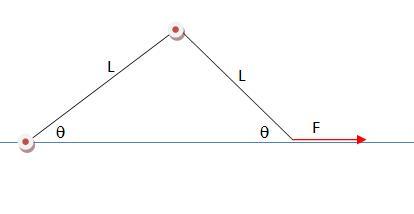Is no one paying attention to this??

The setup shown consists of two identical rods (mass m) hinged together at the ends.
This setup is held in the position shown.
Now we start applying a constant force F to the free end as shown
Find the initial angular acceleration of the rods.
-
UP 0 DOWN 0 5 39

39 Answers
I didnt get the ques...
even if right side rod moves..what effect will it have on left side rod ??
yeah α will hav equal magnitude since the common hinge 4 both comes down with fixed acceleration........trying to figure out the soln nw..........
@Philip..wats the answer...i'll post soln only if i get correct answer..
no. i will not post the answer rite now.
i posted it here
http://targetiit.com/iit-jee-forum/posts/round-and-round-and-snap-12357.html
and see the result. Its gone dead...
i tried it in varoius ways..but found that soln is this much only
taking torque abt COM of right rod,
τ=ICentroidal.αright
F(Lsinθ2)=mL212.αright
=> αright=6FsinθmL
plz tell me if it is rite or wrong....
why are you all neglecting the forces at the hinge....
and the force of gravity
ya...i missed forces of hinge....but why forces of gravity ??they wont produce torque abt CM